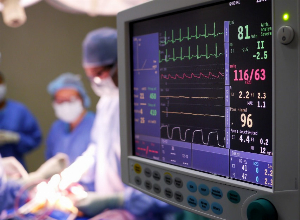The different heart surgery techniques: everything there is to know!
Published 28 Jul 2023 • By Claudia Lima
Heart disease is a major health problem worldwide, and is the leading cause of medical consultations. It is the 1st cause of death worldwide, and the 1st cause of death among males in the UK.
There are a number of treatments available to treat heart conditions.
Thanks to advances in medical science, a number of surgical techniques have been developed for this purpose.
What is cardiovascular disease? What is heart surgery? What are the different types of heart surgery?
Find all the answers in our article!

What is cardiovascular disease?
Cardiovascular diseases are diseases of the heart and blood vessels. They are generally divided into:
- Peripheral vascular diseases, which affect the vessels in the arms, legs and trunk (except those supplying the heart),
- Cerebrovascular disease, which affects the vessels supplying the brain.
Treating a patient suffering from cardiovascular disease requires a number of therapeutic approaches: dietary hygiene measures and drug treatment is usually the first line of defense. But sometimes surgery becomes necessary.
What is heart surgery and when can it become necessary?
Surgery is a medical procedure in which doctors make an incision in the body to treat a disease, lesion or other health problem. Heart surgery covers all surgical procedures performed on the heart. The doctor who performs the operation is called a thoracic and cardiovascular surgeon.
Most heart surgery operations are performed under extracorporeal circulation, also known as a heart pump or heart-lung machine, as the heart has to be stopped to be immobilised during the operation. Many surgical procedures require the patient's chest to be opened, and some are performed with an open heart.
However, technological advances now make it possible to operate via an artery, using catheters fitted with specific instruments (balloons, stents or springs) that allow to modify the blood vessel. This is called interventional cardiology.
Heart surgery is not trivial, and whenever possible patients should be given a clear explanation of the procedure, its benefits and risks.
Many heart disorders require surgery, including congenital heart disease, coronary artery disease, heart failure, heart valve disease and aortic aneurysms.
Heart surgery can take place at different stages of a patient's life:
- At birth, for congenital cardiac malformations that cause anomalies in the structure of the heart,
- Following a heart attack, when urgent intervention is necessary, it should take place no more than 90 minutes after the first signs of a myocardial infarction,
- When the disease worsens, if heart function has deteriorated and medication is no longer sufficient,
- As a preventive measure, in cases where the patient's disease could lead to cardiac arrest.
What are the main types of heart surgery?
Here are the most commonly performed heart surgeries:
Coronary bypass
This is a common surgical procedure used to treat coronary artery disease, when a coronary artery becomes narrowed.
It involves creating new routes around the blocked coronary arteries using blood vessels taken from elsewhere in the body, often the saphenous veins or internal mammary arteries. The operation is performed under general anaesthesia. After the surgeon has made the incision, the heart is temporarily stopped, and an extracorporeal circulation device takes over the patient's blood circulation during the operation. Grafts are harvested and connected to the other arteries.
When it is possible, a non-surgical alternative can be offered instead: angioplasty with or without stenting.
Angioplasty with or without stenting
This non-surgical, interventional procedure is designed to widen narrowed or blocked coronary arteries so that arterial circulation can be restored to normal.
It involves inserting a small catheter into an artery, either in the groin (femoral artery) or in the wrist (radial artery). This is done under local anaesthesia. The catheter is guided, under X-ray control (using a contrast agent - fluoroscopy), to the area of blockage in the artery concerned. A small deflated balloon is inserted to the site of the blockage, then inflated to enlarge the area.
Angioplasty is performed with or without the insertion of a stent. In some cases, a stent is inserted into the artery to keep it open. Stents are generally made of metal, and may or may not be coated with a drug to help prevent recurrence of the stenosis (narrowing of the artery).
The procedure takes around fifteen minutes and is not painful.
Heart valve surgery
This technique is used to repair or replace damaged or defective heart valves.
Heart valve surgery is performed under general anaesthesia, with the surgeon gaining access to the heart by opening the chest. For repair, after restoring the valve components, a prosthetic ring is fitted to consolidate the repair and restore the ring to its normal shape. For replacement, mechanical or biological prostheses are used.
Aortic aneurysm repair
An aortic aneurysm is an abnormal dilation of the wall of the aorta, the body's main artery. Aortic aneurysm repair surgery may involve resection and reconstruction of the dilated section of the aorta using a synthetic graft or a vascular prosthesis. This operation is designed to prevent the rupture of the aneurysm, a potentially fatal condition. The operation is performed under general anaesthesia.
Depending on the type of aneurysm, a less invasive technique called an aortic stent graft, developed by interventional cardiology, may be considered.
In the case of an abdominal aortic aneurysm, the operation is the responsibility of a vascular surgeon, not the cardiac one.
Heart transplantation
A heart transplantation is performed to replace a failing heart with a healthy heart from a compatible donor. A pre-transplant assessment is required to evaluate the patient's general health. Heart transplants are not possible for people over the age of 65, those suffering from ongoing or recent cancer, or those with certain kidney or liver diseases.
The patient is then placed on a waiting list for a transplant and must remain available 24 hours a day and be able to arrive at the hospital within 2 hours of being informed that an organ is available.
To avoid infectious complications, patients with heart transplants are kept in hospital for a fortnight. Immunosuppressive drugs are administered to prevent the recipient's immune system from rejecting the new heart.
There are many other medical procedures and other less invasive methods to treat heart conditions, such as:
- Pacemaker implantation,
- Atrial fibrillation ablation,
- Implantation of an artificial heart,
- Electrical cardioversion,
- Transmyocardial laser revascularisation (TMR), etc.
All of these cardiac surgeries have numerous benefits and help to improve cardiovascular function. However, as with any surgery, there are risks of infection, bleeding, blood clots, allergic reactions and complications related to anaesthesia. There are also rare risks of a haemorrhage, stroke, heart or respiratory failure, intolerance to prostheses and nosocomial infections.
Today, research is advancing on all fronts to defeat cardiovascular disease. Among the most significant advances we can name the development of markers for early heart disease detection, stem cell transplants to improve heart function in the case of heart failure, the development of new treatments for stroke, etc.
Sources :
Maladies cardiovasculaires, who.int/fr
Maladies cardiovasculaires, frm.org
Chirurgie cardiaque : qu'est-ce que c'est, sante.lefigaro.fr
Dans quelles situations avoir recours à une chirurgie cardiaque, deuxiemeavis.fr
Fédération française de cardiologie, fedecardio.org
Comprendre l'intervention coronaire percutanée (ICP), msdmanuals.com

 Facebook
Facebook Twitter
Twitter


